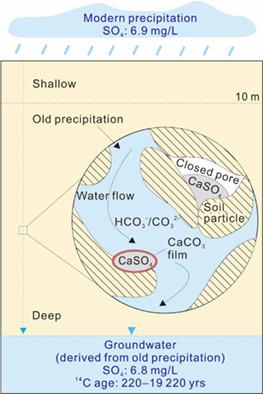当前位置:
X-MOL 学术
›
Hydrol. Process.
›
论文详情
Our official English website, www.x-mol.net, welcomes your feedback! (Note: you will need to create a separate account there.)
Origin of sulphate in the unsaturated zone and groundwater of a loess aquifer
Hydrological Processes ( IF 3.2 ) Pub Date : 2021-04-08 , DOI: 10.1002/hyp.14166 Yin Long 1, 2 , Tianming Huang 1, 2, 3 , Fen Zhang 1, 2 , Zhenbin Li 1, 2 , Baoqiang Ma 1 , Yiman Li 1 , Zhonghe Pang 1, 2
Hydrological Processes ( IF 3.2 ) Pub Date : 2021-04-08 , DOI: 10.1002/hyp.14166 Yin Long 1, 2 , Tianming Huang 1, 2, 3 , Fen Zhang 1, 2 , Zhenbin Li 1, 2 , Baoqiang Ma 1 , Yiman Li 1 , Zhonghe Pang 1, 2
Affiliation

|
The use of the sulphate mass balance (SMB) between precipitation and soil water as a supplementary method to estimate the diffuse recharge rate assumes that the sulphate in soil water originated entirely from atmospheric deposition; however, the origin of sulphate in soil and groundwater is often unclear, especially in loess aquifers. This study analysed the sulphur (δ34S‐SO4) and oxygen (δ18O‐SO4) isotopes of sulphate in precipitation, water‐extractable soil water, and shallow groundwater samples and used these data along with hydrochemical data to determine the sources of sulphate in the thick unsaturated zone and groundwater of a loess aquifer. The results suggest that sulphate in groundwater mainly originated from old precipitation. When precipitation percolates through the unsaturated zone to recharge groundwater, sulphates were rarely dissolved due to the formation of CaCO3 film on the surface of sulphate minerals. The water‐extractable sulphate in the deep unsaturated zone (>10 m) was mainly derived from the dissolution of evaporite minerals and there was no oxidation of sulphide minerals during the extraction of soil water by elutriating soil samples with deionized water. The water‐extractable concentration of SO4 was not representative of the actual SO4 concentration in mobile soil water. Therefore, the recharge rate cannot be estimated by the SMB method using the water‐extractable concentration of SO4 in the loess areas. This study is important for identifying sulphate sources and clarifying the proper method for estimating the recharge rate in loess aquifers.
中文翻译:

黄土含水层非饱和区和地下水中硫酸盐的来源
利用降水和土壤水之间的硫酸盐质量平衡(SMB)作为估算弥散补给率的补充方法,是假定土壤水中的硫酸盐完全来自大气沉积。但是,土壤和地下水中硫酸盐的来源通常不清楚,尤其是在黄土含水层中。该研究分析了硫(δ 34个S-SO 4)和氧(δ 18 O形SO 4)降水,水可提取的土壤水和浅层地下水样品中的硫酸根同位素,并将这些数据与水化学数据一起用于确定黄土含水层厚不饱和区和地下水中的硫酸盐来源。结果表明,地下水中的硫酸盐主要来自旧的降水。当沉淀物通过不饱和区渗入地下水以补给地下水时,由于形成了CaCO 3,硫酸盐很少被溶解。硫酸盐矿物表面上的薄膜。深部不饱和区(> 10 m)中的水可萃取硫酸盐主要来自蒸发矿物质的溶解,在用去离子水冲洗土壤样品的过程中,土壤水的萃取过程中没有硫化物矿物的氧化。可水萃取的SO 4浓度不能代表流动土壤水中的实际SO 4浓度。因此,补给率无法通过SMB方法使用黄土区域中水可萃取的SO 4浓度来估算。这项研究对于确定硫酸盐来源和阐明估算黄土含水层补给率的正确方法非常重要。
更新日期:2021-04-20
中文翻译:

黄土含水层非饱和区和地下水中硫酸盐的来源
利用降水和土壤水之间的硫酸盐质量平衡(SMB)作为估算弥散补给率的补充方法,是假定土壤水中的硫酸盐完全来自大气沉积。但是,土壤和地下水中硫酸盐的来源通常不清楚,尤其是在黄土含水层中。该研究分析了硫(δ 34个S-SO 4)和氧(δ 18 O形SO 4)降水,水可提取的土壤水和浅层地下水样品中的硫酸根同位素,并将这些数据与水化学数据一起用于确定黄土含水层厚不饱和区和地下水中的硫酸盐来源。结果表明,地下水中的硫酸盐主要来自旧的降水。当沉淀物通过不饱和区渗入地下水以补给地下水时,由于形成了CaCO 3,硫酸盐很少被溶解。硫酸盐矿物表面上的薄膜。深部不饱和区(> 10 m)中的水可萃取硫酸盐主要来自蒸发矿物质的溶解,在用去离子水冲洗土壤样品的过程中,土壤水的萃取过程中没有硫化物矿物的氧化。可水萃取的SO 4浓度不能代表流动土壤水中的实际SO 4浓度。因此,补给率无法通过SMB方法使用黄土区域中水可萃取的SO 4浓度来估算。这项研究对于确定硫酸盐来源和阐明估算黄土含水层补给率的正确方法非常重要。



























 京公网安备 11010802027423号
京公网安备 11010802027423号